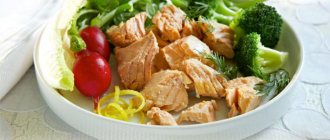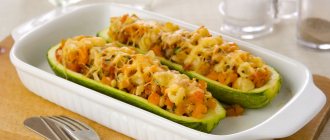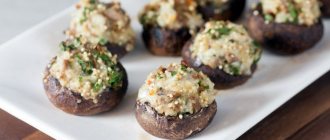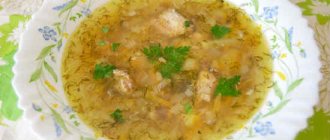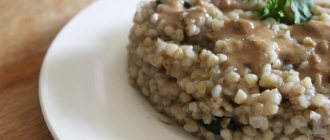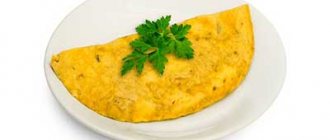Dietary properties of flounder:
Have you ever met such an unusual fish - flattened, with eyes on one side, with a greenish color? Of course, this is flounder. The wonderful taste of this fish is combined with juicy, tender meat of a beautiful white color.
How many calories are in this fish? This indicator is of interest to many readers, especially those who watch their figure and do not want to gain excess weight. So, let's take a closer look at the benefits of flounder and what calorie content flounder has.
This fish is a rich source of proteins with a well-balanced amino acid composition. Such protein from fish, unlike animal proteins, is more quickly absorbed by the human body. Flounder contains very little fat - up to 3%. Thanks to this, it is an ideal product for dietary nutrition. And the small amount of fat that this type of fish contains is easily digestible, without causing any damage to the body of a sick or weakened person.
Flounder is recommended for dietary nutrition also because its meat contains a number of vitamins: A, E, thiamine, riboflavin, nicotinic acid, pyridoxine. In addition, this fish has a number of very useful mineral components, including: potassium, sodium, calcium, iron, selenium, zinc, phosphorus, magnesium, copper, iodine. And also, fish, including this one, is a product that is good for teeth, bone and muscle tissue.
This fish should certainly be included in the diet of patients and people recovering from serious illnesses or operations.
The presence of the chemical elements we need in it makes flounder indispensable for diseases of the thyroid gland and bronchitis.
Regular inclusion of this fish in the diet reduces the likelihood of developing atherosclerosis and cancer, thanks to the amino acids and fatty acids present in its composition. A positive effect of flounder on male potency has been noted.
The low calorie content of this fish allows it to be considered a dietary food. It is useful for those who want to lose weight, although, like everything else, in moderation. At the same time, flounder fats do not provoke an increase in cholesterol due to the high content of fatty acids. Consuming it can eliminate the need to buy expensive nutritional supplements with omega-3 and 6. The proteins in flounder are absorbed many times faster than chicken or beef, and in larger quantities. Therefore, this fish is considered especially useful for people engaged in heavy intellectual or physical work, athletes, students and preschool children, as well as for pregnant women.
And from a culinary point of view, this is a truly universal product that can be fried, stewed and boiled.
How to choose tasty and healthy flounder
In order for the full benefits of flounder to manifest itself for the human body, it is necessary to include excellent quality fish in your diet. To do this, you need to remember a number of rules when choosing and purchasing it:
- Preference should be given to fish that were grown and caught in an ecologically clean area.
- It is best to choose a product ranging in size from 300 g to 0.5 kg.
- Be sure to check the gills of the fish. They should be red or pink.
- Pressing on the flounder should not leave any dents. You should also evaluate the presence of mucus on the surface of the product.
Store-bought flounder should be cut up and cooked immediately. It can be stored in the refrigerator. It is highly undesirable to keep fish in the freezer.
How many calories are in flounder?
Let's clarify what the energy value of a fish like flounder is. So, what exactly is the calorie content of flounder? And here it is:
Calorie content of fresh flounder is:
only 83 kcal per 100 g. product
Proteins, fats and carbohydrates (BJU) of fresh flounder per 100 grams:
Proteins - 16.5
Fats – 1.8
Carbohydrates – 0.0
Which is very little for marine varieties of fish. That is why it is considered a dietary product useful in therapeutic nutrition.
The calorie content of boiled flounder is:
103 kcal per 100 g. product
Proteins, fats and carbohydrates (BJU) of boiled flounder per 100 grams:
Proteins - 18.3
Fats – 3.3
Carbohydrates – 0.0
And the calorie content of hot smoked flounder is:
192 kcal per 100 g. product
Proteins, fats and carbohydrates (BJU) hot smoked per 100 grams:
Proteins - 22.0
Fats – 11.6
Carbohydrates – 0.0
Recipe? Recipe!
What dishes can be prepared from this fish? Many. Here is one of the recipes:
Fried flounder:
This is a very simple recipe that does not require much time.
Products:
- Flounder
- Eggs - 1 piece
- Lemon juice - 1 teaspoon
- Breadcrumbs
- Salt and spices
Beat the egg with lemon juice, salt and spices. Pre-gutted and washed fish are brushed on both sides with the resulting mixture of eggs. Then breaded with breadcrumbs. The fish is placed in a heated frying pan and fried on both sides. Done - enjoy the result! Moreover, the low calorie content of flounder will not ruin your figure.
Flounder on a bed of vegetables:
Products:
- Flounder (large) – 1 piece
- White cabbage – 250 g
- Carrots - 2 pcs.
- Onions - 2 pcs.
- Mayonnaise - 250 g
- Lemon - 1/2 pcs
- Spices (salt, pepper - to taste)
- Seasoning (for fish, to taste)
Clean the flounder (any other sea fish will do), gut it and cut it into portions.
Season with salt and pepper (you can also sprinkle with fish seasoning) and sprinkle with lemon juice. Set aside. Shred the cabbage into strips. Place the cabbage in a colander, pour over boiling water, and immediately rinse with cold water. Peel the carrots and grate them on a coarse grater, cut the onion into half rings, place in a colander and rinse well with cold water.
Grease a baking sheet or mold with margarine. Place carrots and smooth. Salt and pepper lightly. Then add the cabbage. Add salt and pepper again. Distribute the onion on top. Place flounder on top. Lubricate the fish pieces well with mayonnaise.
Bake in the oven at 180*C for 35-40 minutes. Ready!
Application
Flounder is subject to any culinary processing. It can be stewed, baked, fried, boiled, salted and smoked. A small drawback, according to some gourmets, is the specific smell. But it is very easy to deal with if you remove the skin from the fish. An excellent addition to fish is lemon juice, which at the same time perfectly removes the smell of fish. Cooks recommend that when frying flounder, place it in a frying pan with the dark side down. It will taste better this way.
Market Analytics
- Black Lives Matter movement: reaction and consequences for the beauty industry
- COVID-19 is changing the rules of the game in the cosmetics market
- Beauty of the future: cosmetic innovations 2021
Convenient search for beauty salons on our website
Beauty salons in Moscow Beauty salons in St. Petersburg Beauty salons in Ekaterinburg Beauty salons in Novosibirsk
Latest blog posts on our website
- Naturecream / Tremella Extract - Snow Mushroom Detox for Skin
- Prostye-sovety / How to visually enlarge your lips with makeup
- Naturecream / Apricot kernel oil for face
- Naturecream / MATRIXYL3000 - the best skin elasticity stimulator
- Naturecream / SPF in Natural Oils
- Naturecream / Geranium (Pelargonium) oil for skin health and beauty
- Prostye-sovety / Save on a beauty salon: procedures that can be done at home
- Naturecream / Growth Factor - brings back youth?
- Oksana-Lezina / 3 effective abdominal exercises from a fitness instructor for beginners
- Prostye-sovety / Making perfect curls at home
Latest forum topics on our website
- Natalya / How to properly make a gelatin mask?
- Mrs._Smith / Badly sunburned! What to do?((
- Ice / Is it necessary to combine fitness classes with a diet?
- Antonova / What can be used for hair loss?
- Radio operatorKat / Who was on a protein diet?
Other articles in this section
| Boiled mussels Mussels are a bivalve mollusk that lives in salt and fresh water. There are two categories of mussels you can find on supermarket shelves. The first is North Atlantic mussels, they are the most common. Typically, they are caught in season from May to July. The second species is the Gulf mussel. They are very similar to their counterparts, but the shell of the North Atlantic is slightly wider. |
| Sevruga in tomato sauce Sevruga is a fish from the sturgeon family. Habitat: Caspian, Azov, Black and other seas. After it was found out what nutritional value this type of fish has, it was specially introduced into these seas. On store shelves, stellate sturgeon is presented in frozen and smoked form. This fish is widely popular due to its affordable price, pleasant taste and numerous beneficial properties. |
| Tilapia (fillet) Tilapia is a small freshwater inhabitant whose appearance resembles a perch. There are dark spots behind the gills of the fish. Tilapia is one of the favorite species in fish farming. This is due to the fact that the fish is unpretentious to conditions and food, and therefore grows very quickly. There are more than one hundred varieties of tilapia. |
| Sturgeon caviar, punched Sturgeon caviar is one of the most valuable, healthy and expensive seafood. Although the color range of caviar in different species of fish of this family varies from silver-gray to black, it is commonly called black caviar. Black caviar has long been considered one of the most important riches of Russia. Moreover, lighter types of caviar and those with larger egg sizes are especially valued. |
| Caspian sprat Caspian sprat is a small commercial fish of the herring family. It lives in the northern and southern parts of the coastal zone of the Caspian Sea. Outwardly it is very similar to herring, but much smaller in size. Representatives of this genus of fish are found in waters with low salinity and do not descend to a depth of below 40 meters. Avoiding temperature fluctuations, in winter they migrate to the south of the Caspian Sea, and in the spring and summer season they concentrate in the northern regions. Caspian sprat grows quite quickly and reaches a length of up to 17 cm, on average the length is 11-13 cm and the weight is from 8 to 10 grams. |
| Sardine in oil Sardine is a small fish from the herring family, no more than 20 cm in length, living in the waters of the Atlantic Ocean and the Mediterranean. Its large scales have a beautiful appearance, shimmering in shades of blue-green in the sun. |
| Stewed cod This type of fish belongs to the cod family and lives in large numbers in the cold waters of the Atlantic Ocean. The body of cod is somewhat elongated and has a greenish or brown tint. The fish can reach two meters in length. For industrial purposes, meter-sized cod and smaller ones are used more. The fish is quite popular among consumers, so its fishing is carried out on a large scale. Depending on their habitat, cod has several subspecies. They distinguish these individuals, in most cases, solely by appearance and size. |
| Boiled pike Pike is a freshwater fish, it is predatory. Her mouth is filled with many sharp teeth pointing towards the inside of her throat. If the pike has grabbed the prey, then there is no way to escape from it. Dimensions can reach up to one and a half meters, and weight up to 35 kg. Its place of residence in the river is thickets and snags. It is very popular in our country. |
| Mackerel in oil Mackerel is a fish from the mackerel family, quite heat-loving and preferably lives in schools. It has an elongated body shape with small scales. The most common mackerel is in the Baltic, North, Mediterranean, Black and Marmara seas, and is also often found off the coast of North America. Most often, mackerel lying on store shelves is of Atlantic or Far Eastern origin. It can be found frozen, canned or smoked. |
| Ruff The ruff fish is one of the representatives of the perch family. This is a freshwater fish, the main habitat of which is European water bodies (rivers, lakes, dams), preferably with a sandy bottom. It is very voracious, feeding on small fish, invertebrates and some plants. The length of an adult individual sometimes reaches more than 20 cm. But usually this type of fish is 10-12 cm in length, the ruff has a mass of about 15-25 grams. |
How is flounder good for weight loss?
The perfectly balanced chemical composition of flounder meat, along with its low calorie content and low content of easily digestible fat by the body, makes this fish a first-class dietary product, allowing it to be included in almost any medical and health menu.
Nutritionists advise using the so-called flounder diet for weight loss, which includes the maximum allowable amount of this fish and salads made from raw vegetables. Of course, such a diet is absolutely not suitable for people suffering from sensitivity to marine fish (food allergies)! The effect of regular consumption of flounder will increase if you follow the principles of a healthy diet. It is unacceptable to eat fried, and therefore oil-soaked fish. Preference should be given to dietary cooking of steamed whole pieces of fish fillet or low-fat fish cutlets.
Beneficial features
Flounder contains a lot of protein and is much superior to beef and chicken in terms of the amount of digestible protein. It is an indispensable product for children and adolescents, pregnant women and people engaged in heavy physical labor.
Vitamin A improves heart function and has a positive effect on human reproductive function. Vitamin E strengthens the walls of blood vessels, prevents the formation of blood clots, slows down aging, and serves as an excellent preventative against skin diseases. Vitamin C restores the nervous system, improves immunity, reduces the risk of strokes and heart attacks.
Selenium, which is found in very large quantities in flounder, reduces the risk of developing cancer cells, protects against infertility, increases potency in men, and normalizes the activity of the endocrine system.
More on the same topic:
2 comments
- Lada Writes, By the way, flounder has white meat, juicy and tender. However, during cooking it acquires a peculiar smell. Some people call this feature of flounder a disadvantage. But you can fight this smell - to do this, remove the skin from the flounder. First, remove the scales from the light side of the fish, then cut off the head of the flounder, remove the entrails and wash the carcass. Next, cut off the fins and tail and, firmly grasping the dark skin at the cut of the tail, remove it with a sharp movement.
- Zhanna writes,
If you clean the fish, add a little salt and fry it with the skin in butter, it will be tender and juicy, with a pleasant creamy taste. "Fish in French"
